In Washington Heights, as part of the George Washington Bridge ramp system, Riverside Drive and Henry Hudson Parkway intertwine and become one. Sounds romantic, no? Anything but. Both roads run right through Fort Washington Park, which is a northern extension of Riverside Park and “faces” the Hudson River. Add the clutter of the railroad tracks belonging to Amtrak, which are sometimes buried under the roads and sometimes emerge to daylight, and you have a somewhat compromised park experience. All this is something of a byproduct of the philosophy of traffic czar Robert Moses, who constructed or reconstructed the lion’s share of NYC’s roads, bridges, large parks and housing projects during much of the 20th Century. In the midst of that century, the auto was on the rise, but that was not enough. Every other mode was to be pushed out and shunted aside, and that meant mass transit and pedestrians suffered compared to the auto. (At that time, bicycles were considered toys, and were a nonfactor in the philosophy.)
A stark illustration of this Mosesian philosophy can be found in the maze of park walks leading to one of NYC’s most beloved landmarks, the Little Red Lighthouse, or, more properly, the Jeffreys Hook Lighthouse. It’s located on the water’s edge immediately south of the George Washington Bridge. You might think the city might have long ago improved the methods pedestrians must use to reach this prime attraction. You would be incorrect about that.
I inspected two ways to cross the maze of roads and rails to reach the Lighthouse. These seem to be the two paths closest — there may be a more streamlined method, but it wouldn’t leave you quite as close as these two do. In classic Moses form, the pedestrian has been left in the dust and only the most dedicated seeker can find the Lighthouse. Here’s what I mean…
Enter Fort Washington Park at Haven Avenue and West 177th. From there…
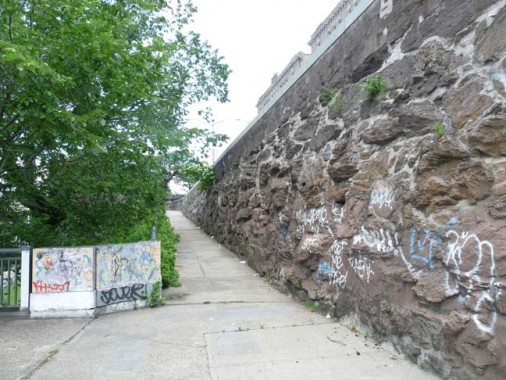
Descend a ramp that leads to…
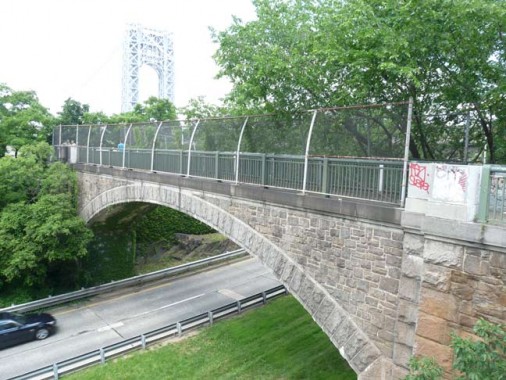

A 1930s-era arch stone bridge, that crosses a northbound lane of Riverside/Hudson. There are tablets on the railway decorated with Neptunian tridents, a lifesaver, ropes, and a shell, probably in honor of the nearby river.
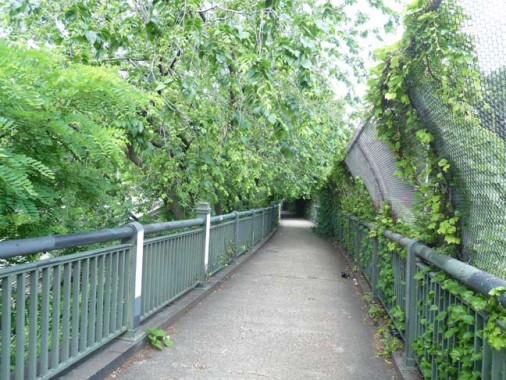
Another ramp, missing its original lamp stanchions, descends from the bridge into…
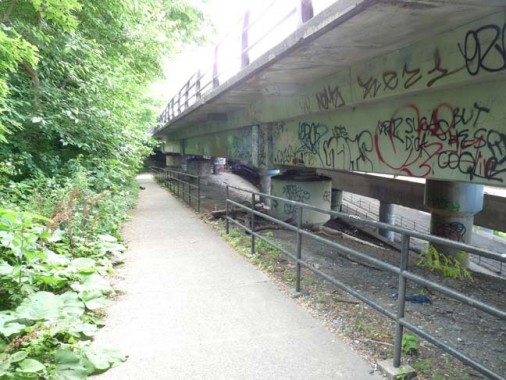
….a southbound ramp trailing along another of the northbound traffic bridges. This in turn…


… curves under the roadway bridge, entering a Stygian region of broken glass, broken sidewalks and long-unrepaired walkway lighting. Imagine how dark this is at night.
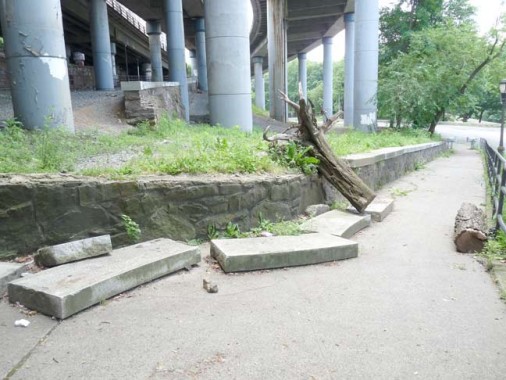
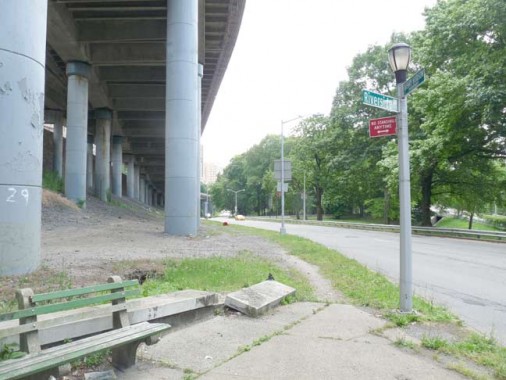
You come out at a bustling surface roadway, with splintered park benches, uprooted trees, and concrete slabs (likely from the retaining wall) lying around. There’s a lamp bearing signs for both Riverside Drive and Henry Hudson Parkway.
I feel more and more at home by the minute. Truly I am in Forgotten realms.
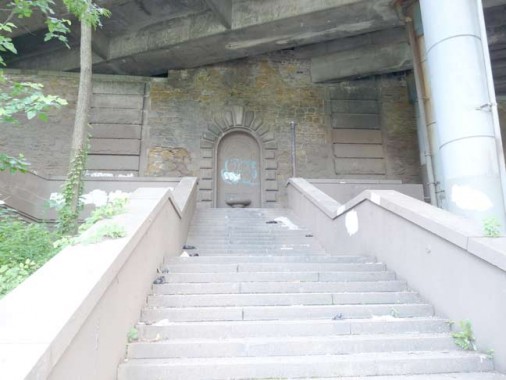
A nearby staircase seems to lead up to what appears to be a blocked-up shrine to some unknown deity.
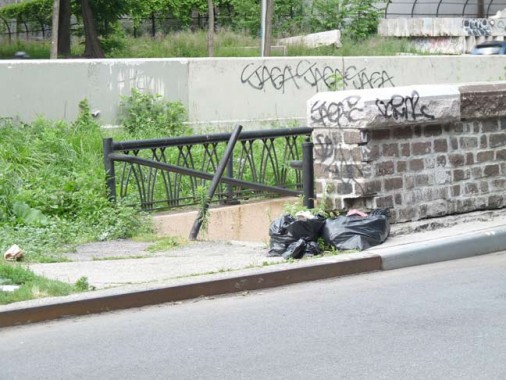
While contemplating how to get across 3 lanes of busy traffic, the issue was settled when I spied a staircase with a rusty handrail and a pile of uncollected garbage. That was the way to get past the roadway. The talismanic scrawlings of the local youth decorate the walls.
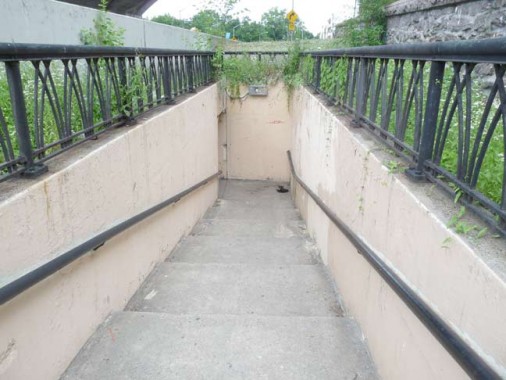
“He who fights with monsters should be careful lest he thereby become a monster. And if thou gaze long into an abyss, the abyss will also gaze into thee.” F. Nietzsche

The local youth are the true arbiters of what condition these pathways will be in, and the local youth have decreed that there will not be any lighting. That would interfere with after-sunset activities.
It would be pointless for the city to spruce up these paths, and re-install lighting. A round-the-clock police presence, and the requisite complaints about police presence, would be necessitated to maintain these paths in any sort of safe and well-lit conditions.

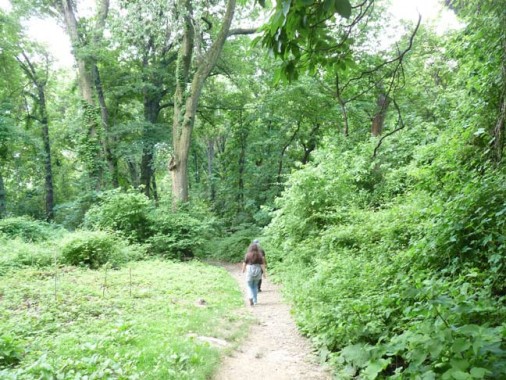
You emerge onto a paved path, but it eventually loses the pavement as you head south and then hugs the Henry Hudson Parkway, but doesn’t go to the Lighthouse. You actually need to head north from the tunnel and go under the George Washington Bridge…

Follow the bicyclists is the usual rule for this kind of voyage of discovery. Seasoned bicyclists always know where the correct path is. Merge with this path north of the Bridge that goes …
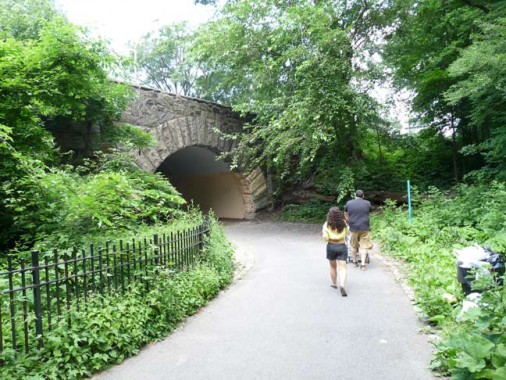
… under yet another stone arch bridge that takes you under the northbound roadway of the Henry Hudson Parkway. We seem to be in civilization again, and there are more people to be seen.
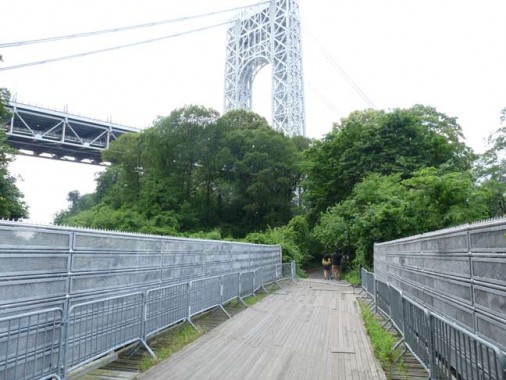

The path runs on a seemingly flimsy, yet rather charming, wood-surface bridge over Amtrak, formerly NY Central. After clearing the railroad you have breached the final barrier to the waterfront, just about.

Care must be taken from here when sneaking a view of the Bridge and the Hudson River. We’re at the edge of a steep cliff, and through some oversight, this section isn’t fenced off.
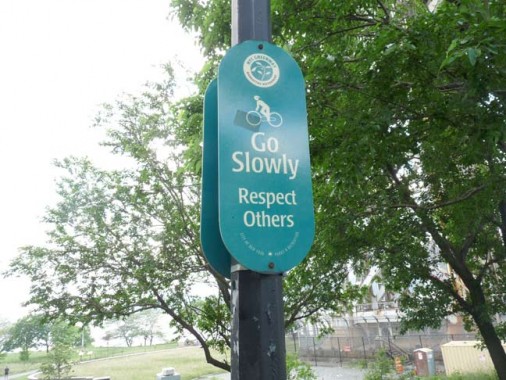
The Department of Transportation rather pathetically entreaties bicyclists to go slowly and respect others, which is like asking the sun not to rise. The DOT is under the mistaken impression that bicyclists and pedestrians are allied parties, and frequently combines bike and pedestrian paths. In reality, bicyclists resent pedestrians for occupying their supposed paths, preventing them from attaining desired speeds (and many cycle at top speed, anyway, endangering pedestrians) who, naturally, resent bicyclists for interrupting their reverie and assumed right to stroll at leisure and see the sights.
The only way to ensure the safety and satisfaction of both groups would be to separate their pathways, which is done all too infrequently.
Little Red
At last, the quarry has been attained, the Little Red, or Jeffrey’s Hook, Lighthouse, which is accompanied by a picnic area and a bored guard who tells you to not take any close up pictures of the bridge tower.
Like many folks of a certain age, I first became aware of the Lighthouse from the CBS morning Captain Kangaroo TV show. Before or after receiving a pingpong-ball shower from Bunny Rabbit, the Captain would sometimes read from a 1942 children’s book by Hildegarde Swift and Lynd Ward called “The Little Red Lighthouse and the Great Gray Bridge,” which remains in print. In the book, the lighthouse becomes despondent when the bridge is built next door, feeling its purpose has been taken away. During a foggy night the Bridge is able to light the way for aircraft while the Lighthouse aids shipping, giving the lesson that everyone has their purpose in life, no matter how seemingly inconsequential.
The 40-foot tall Lighthouse was first built in 1880 and served as the North Hook Beacon off Sandy Hook, NJ in that role until 1917. It was thought obsolete at that point — and was in the line of fire from gun batteries at Fort Hancock at a time when a German invasion was not out of the question –and placed into storage, but it was reassembled in 1921 and placed here at Jeffreys Hook, then considered a dangerous spot for shipping.
The Lighthouse was overshadowed by the GWB in 1931, was decommissioned in 1947, and there was thought of demolition by 1951. However the public remembered Swift and Ward’s book, and petitioned the city for its survival. By the end of that year the Lighthouse was under the jurisdiction of the NYC Department of Parks (headed by one Robert Moses).
The Lighthouse (no longer in official use, but still active) uses a blinking acteylene lamp focused by a 5th order Fresnel lens of cut glass prisms. The Lighthouse employs one second of light followed by two seconds of darkness: every active lighthouse uses a specific sequence of light and darkness. It also has a fog bell.
I’m stumped by the inscription “T.H.M. J.M. B.” on the door, if anyone knows what that refers to.


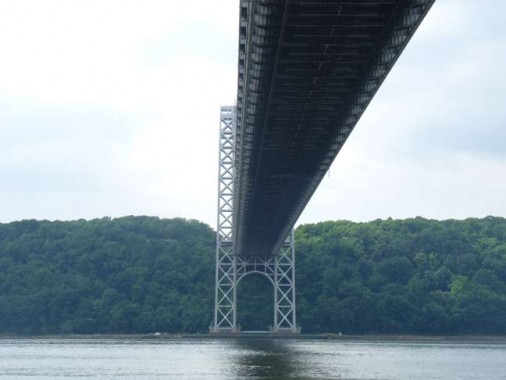
3 views of the Hudson River and New Jersey, from the lighthouse site.

This tablet is one of many identifying signs at the Lighthouse site.

Lighthouse picnic area. It’s easier to approach the Lighthouse from the north or south, along the Riverside/Fort Washington Park paths. It’s a killer getting there from the east.
![]()
A set of spotlights of unknown vintage lights up the Bridge at night.

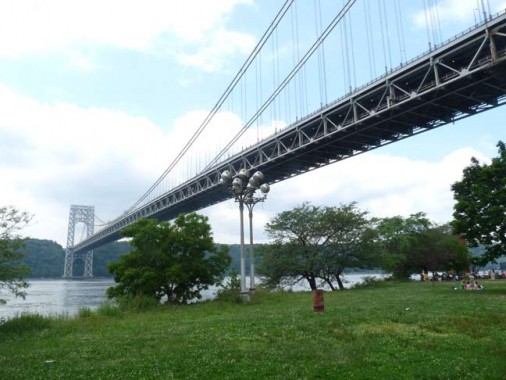
“The George Washington Bridge over the Hudson is the most beautiful bridge in the world. Made of cables and steel beams, it gleams in the sky like a reversed arch. It is blessed. It is the only seat of grace in the disordered city. It is painted an aluminum color and, between water and sky, you see nothing but the bent cord supported by two steel towers. When your car moves up the ramp, the two towers rise so high that it brings you happiness; their structure is so pure, so resolute, so regular that here, finally, steel architecture seems to laugh. The second tower is very far away; innumerable vertical cables, gleaming across the sky, are suspended from the magisterial curve that swings down and then up. The rose-colored towers of New York appear, a vision whose harshness is mitigated by distance.” – Le Corbusier
Not enough time to talk about the GWB in depth here, but Steve Anderson does on his eternal NYCRoads site.

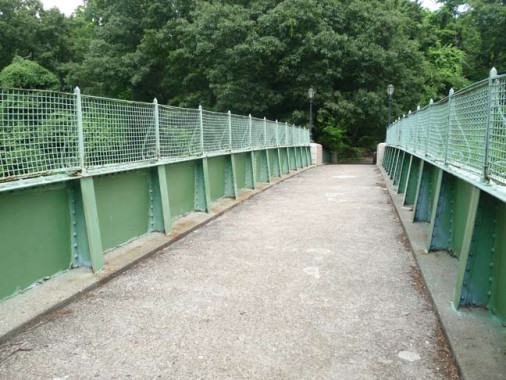
Time to head back, and I did over this pathway, which can also serve as a way in. It runs over this masonry and iron bridge over Amtrak — it’s several decades old, as you can tell by the slight ornamentation.
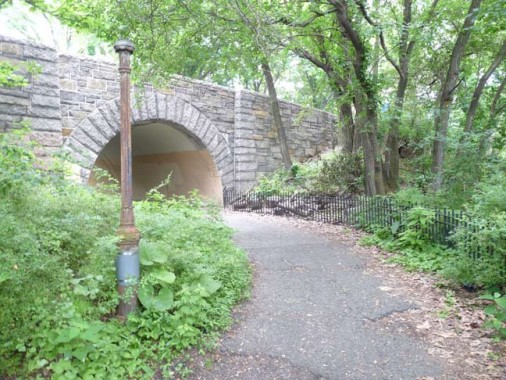
The path gradually leads up a hill lined by rusted lamps that haven’t seen a lightbulb change for quite awhile. Under another masonry arch…

A set of gradual steps leads up a hill…
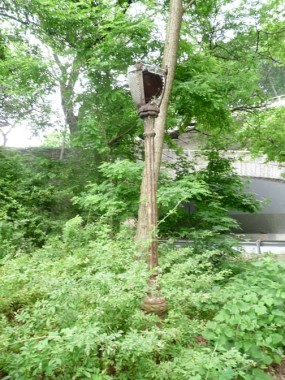

…Thence past a park lamp whose now-rare caged luminaire is still partially intact. In the 50s and early 60s these were standard issue in parks, as vandalism was mainly thwarted by putting the lightbulb inside a metal cage. After that the DOT and Parks turned to plastic.
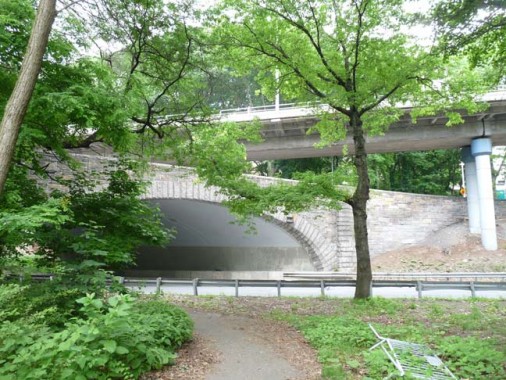
We have yet to ford the Henry Hudson Parkway. Here we do it on a masonry bridge that crosses the southbound lanes and runs under the northbound lanes.
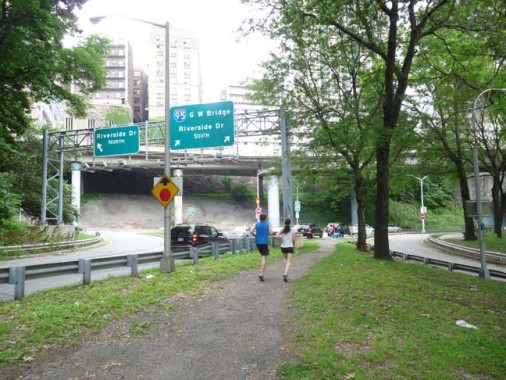
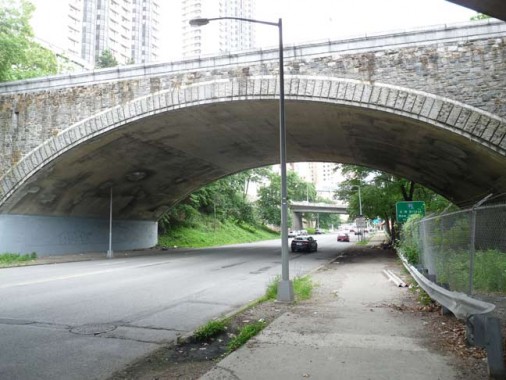
And we’re out, on Riverside Drive, just north of Presbyterian Medical Center.
More: Lighthouses of New York, Jim Crowley, Hope Farm Press 2000
6/19/12


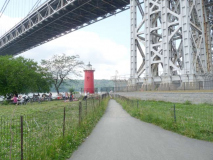
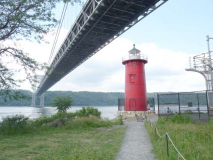
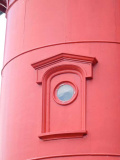
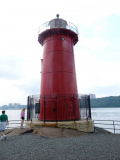
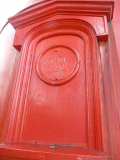
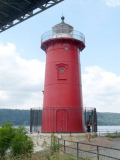
19 comments
You can also walk to the base of 181st street, right up riverside drive as if you were to walk onto the West Side Highway, and then across the footbridge on 181st over the WSH and then down to the same bike path. Much easier, and safer.
There had to be an easier way
The lamps of unknown vintage are known to me; they date back to the 1964 New York Worlds Fair at which time they were set up to illuminate the GW Bridge from both Jersey and New York; the NJ side ones are apparently gone but the New York side ones still stand; albeit not lit anymore.
I remember in the early 70s that lighthouse was trashed-and I mean trashed!
Im surprised they were able to restore it
In that neighborhood I ll give it another 10 yrs before it again looks like that
Let’s not forget that it’s been looking this great for a while now “in that neighborhood.” Though all parts of New York change, I resent the notion that the people who live in Inwood or The Heights are the ones who ruin things – everything needs repair and upkeep.
Kevin, you were really operating outside the Pale on this one. Glad you made it back in one piece.
Yeah, Kevin. Next time visit the Grand Canyon (which can be reached via the Grand Canyon RR ).
Looks to me like you might run across some of those dudes from “The Warriors” in that area, you know the guys with the painted faces and baseball bats.
“Warriors, come out and play.”
so cornery
Kevin, what a journey. How long did it take you? Those parks and paths are in horrible shape, probably would do no good for anyone to report the disrepair to 311.
Yes,thats right.I forgot all about the”Baseball Furies” from The Warriors.
Kind of like a cross between Kiss and the Yankees
I’m from argentina and like your fantastic site.
Any posibility of posting a map drawing showing the way that you take to the lighthouse?
the set of spot lights of unknown origin you show are unfortunately not unknown to me; they come from the time of the 1963 new york worlds fair which was when they were erected to illuminate the bridge for the fair. there are also additional towers when you ascend the hill past the lighthouse—there are also ones on the jersey side.
I am a Riverdale, NY native (1966-2000) who now lives in Pasadena, CA. Wow, do I miss NYC. CAL is like living in a 3rd world country. I come back 2-3x a year for the food, my METS, the subway, and the awesome people. Even though I’ve passed this little red lighthouse 10,000 times in my life, I’ve never walked to it. Small world as my dad now lives across/faces the lighthouse in Ft. Lee. When the bridge was completed in 1931/32, my mom was born. What a great time of change in NYC in the early 30’s…Empire State Building, the GWB, Lincoln Tunnel, Holland Tunnel, etc. Long live the greatest city in the world (4/20/15).
is there any signage from the site of the original Ft Washington of the Rev War ? If so, what is the easiest and safest way to access it, please ….; walking directions; how close by car, and how safe is it today (8/2015)
Anyone know the significance of the staircase leading to the blocked door “for an unknown diety?” I stumbled upon it and couldn’t figure out its purpose.
did you ever find out what the inscription refers to?
Great work as usual! Just a note, there was no chance of a German invasion in 1917.